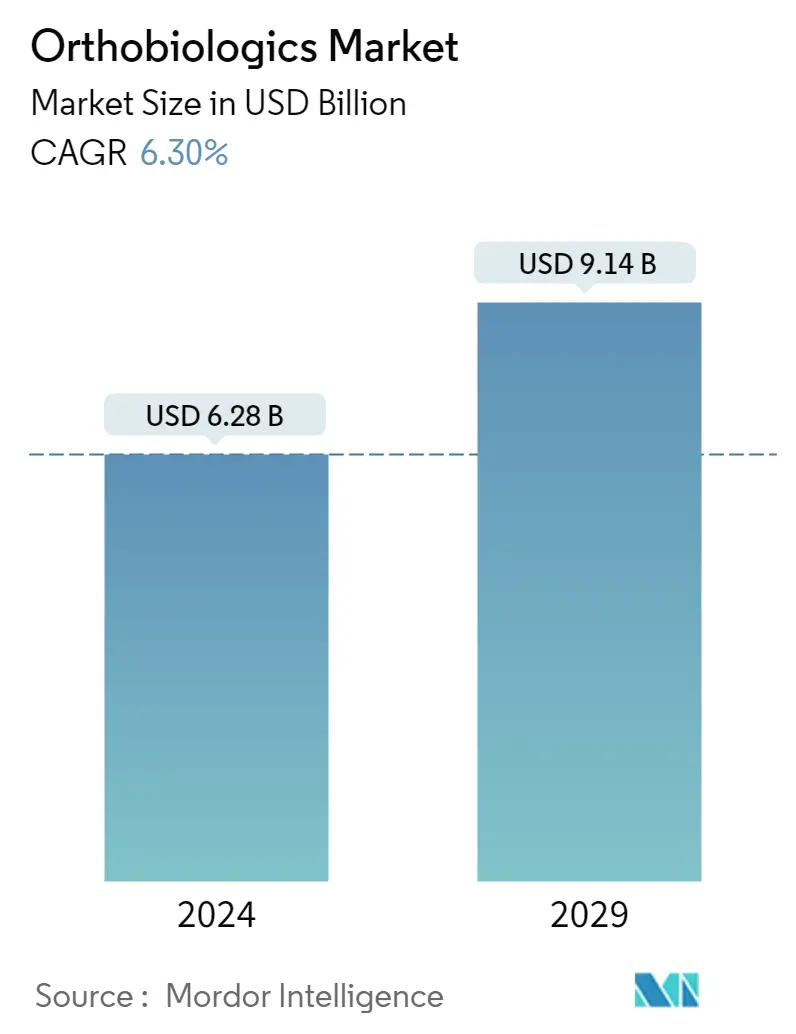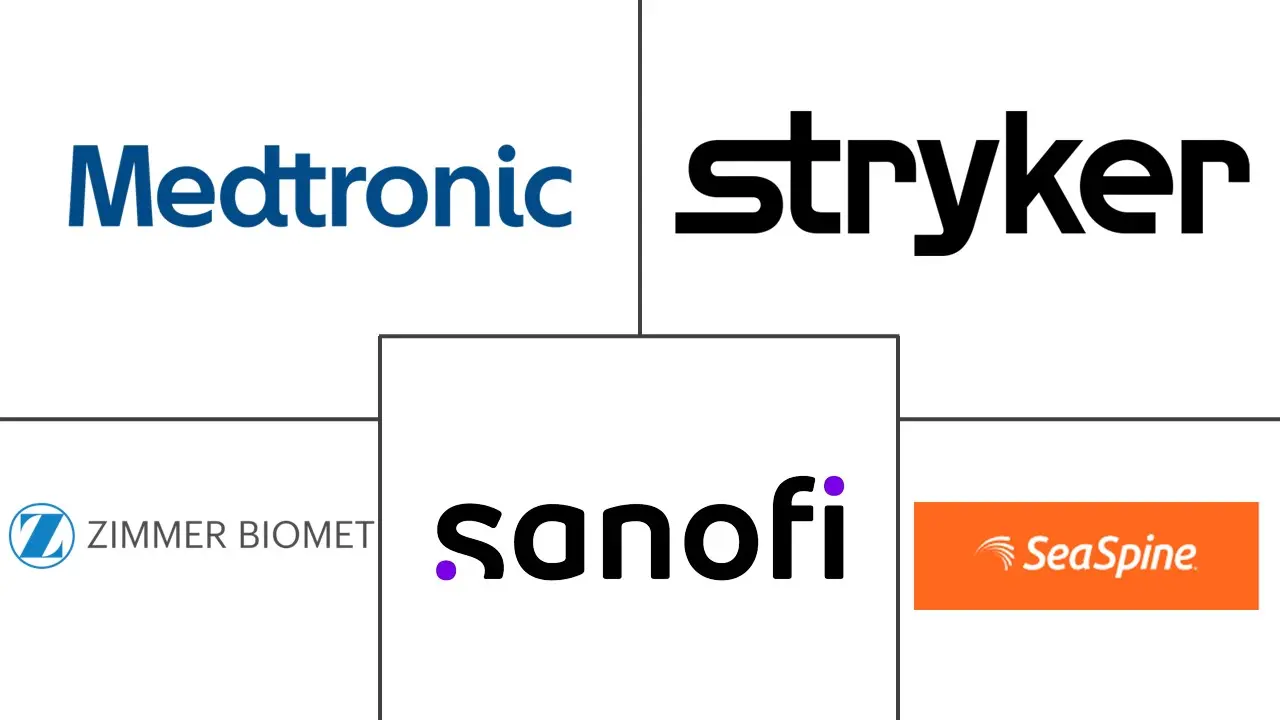Market Size of Orthobiologics Industry

| Study Period | 2021 - 2029 |
| Market Size (2024) | USD 6.28 Billion |
| Market Size (2029) | USD 9.14 Billion |
| CAGR (2024 - 2029) | 6.30 % |
| Fastest Growing Market | Asia Pacific |
| Largest Market | North America |
Major Players
*Disclaimer: Major Players sorted in no particular order |
Orthobiologics Market Analysis
The Orthobiologics Market size is estimated at USD 6.28 billion in 2024, and is expected to reach USD 9.14 billion by 2029, growing at a CAGR of 6.30% during the forecast period (2024-2029).
The COVID-19 outbreak is an unprecedented health concern and has significantly impacted the orthobiologics market globally. According to a 2021 update by the National Safety Council (NSC) in America, the Consumer Product Safety Commission (CPSC) reported that during the first seven months of the COVID-19 pandemic, visits to emergency departments for consumer product-related injuries decreased by 24%. The highest decrease in injuries was sports-related injuries associated with track and field. Hockey, soccer, baseball, football, and basketball witnessed a more than 60% reduction from March through September 2020. Thus, the COVID-19-imposed lockdown impacted the orthobiologics market significantly. However, with a better screening process, the market is now opening up, which is increasing growth. For instance, in April 2022, an article published in the Europe PMC stated that after a year of maintaining 'non-COVID' hospital status for elective surgery, restrictions began to ease as the COVID-19 positivity rate dropped to 1.2% in Nassau County, New York on 1 May 2021. On 3 May 2021, on-site pre-surgical testing (PST) appointments resumed. Thus, the market is expected to grow in the future.
The major factors driving the growth of the orthobiologics market are increased incidence of sports injury, road accidents, osteoarthritis, and increasing adoption of minimally invasive surgeries. As per the 2020 statistics by the United Kingdom National Health Service, tennis elbow is a common condition affecting about 1-3% of the population, indicating about four to seven cases per 1000 every year. The high incidences of sports injuries boost the demand for orthobiologics for effective treatment, thus fueling the market.
The global increase in the number of geriatrics and obese people is likely to lead to consequences like greater incidences of osteoarthritis. Consequently, the geriatric population and population with obesity are at higher risk of musculoskeletal disorders. According to the World Health Organization (WHO), approximately 1.71 billion people had musculoskeletal conditions worldwide in 2021. Among musculoskeletal disorders, low back pain causes the highest burden, with a prevalence of 568 million people. According to the report published by Versus Arthritis stated that over 20 million people in the United Kingdom (around a third of the population) live with a musculoskeletal (MSK) condition, such as arthritis and low back pain. Overall, 21% of the UK population lived with illness and disability (YLD) and was associated with MSK conditions. Low back, neck pain, and osteoarthritis are the most common causes of pain and disability. The source stated that over 430,000 people have rheumatoid arthritis, around 12,000 children have juvenile idiopathic arthritis, 220,000 people have axial spondylarthritis, and around 100,000 people have psoriatic arthritis. Nearly 8.5 million people have osteoarthritis, 10 million have back pain, 1.7 to 2.8 million people have fibromyalgia, 3 million have osteoporosis, and around 500,000 fragility fractures occur yearly. Therefore, with the increase in musculoskeletal injuries, the demand for orthobiologics is expected to increase, driving the market growth.
Moreover, launching new products and strategic initiatives adopted by key market players is expected to boost the studied market growth. For instance, in April 2021, Ventris Medical launched Allocell AF, a next-generation osteoinductive fiber allograft. It enhances intra-operative handling and increases biological responsiveness at the defect site.
Thus, due to the factors such as increased incidence of injury, obese people, and product launches, the studied market is expected to grow significantly during the study period. However, the high cost of biologic-based treatments and preference for other alternatives is expected to hinder the market growth.
Orthobiologics Industry Segmentation
As per the report's scope, orthobiologics are used by orthopedic surgeons to help injuries heal more quickly. They quicken the healing of broken bones and injured muscles, tendons, and ligaments. These products are made from substances that are naturally found in our bodies. The Orthobiologics Market is Segmented by Product (Viscosupplementation Products, Demineralized Bone Matrices, Synthetic Orthobiologics, Bone Morphogenic Protein, Allografts, and Others (Plasma-rich Protein, and Bone Marrow Aspirate Concentrate)), Application, (Osteoarthritis and Degenerative Arthritis, Spinal Fusion, Soft-tissue Injuries, and Others (Fracture Recovery, and Maxillofacial and Dental Applications)), End User (Hospitals, Orthopedic Clinics, and Ambulatory Care Centers, Academic and Research Institutes, and Dental Clinics and Facilities), and Geography (North America, Europe, Asia-Pacific, Middle East & Africa, and South America). The market report also covers the estimated market sizes and trends for 17 countries across major global regions. The report offers the value (USD million) for the above segments.
| By Products | |
| Viscosupplementation Products | |
| Demineralized Bone Matrices | |
| Synthetic Orthobiologics | |
| Bone Morphogenic Protein | |
| Allografts | |
| Other Products (Plasma-rich Protein and Bone Marrow Aspirate Concentrate) |
| By Application | |
| Osteoarthritis and Degenerative Arthritis | |
| Spinal Fusion | |
| Soft-tissue Injuries | |
| Other Applications (Fracture Recovery and Maxillofacial and Dental Applications) |
| By End User | |
| Hospitals, Orthopedic Clinics, and Ambulatory Care Centers | |
| Research and Academic Institutes | |
| Dental Clinics and Facilities |
| Geography | ||||||||
| ||||||||
| ||||||||
| ||||||||
| ||||||||
|
Orthobiologics Market Size Summary
The orthobiologics market is poised for significant growth over the forecast period, driven by an increasing incidence of sports injuries, road accidents, and osteoarthritis, alongside a rising geriatric and obese population. The market's expansion is further supported by the growing adoption of minimally invasive surgeries and the introduction of innovative products by key industry players. The COVID-19 pandemic initially disrupted the market due to reduced emergency department visits for sports-related injuries, but as restrictions eased and elective surgeries resumed, the market began to recover. The demand for orthobiologics is expected to rise as musculoskeletal disorders become more prevalent, particularly among the elderly and those with obesity, thereby fueling market growth.
Strategic initiatives such as product launches, mergers, and acquisitions are anticipated to enhance the market's trajectory. Notable developments include the introduction of next-generation osteoinductive fiber allografts and FDA-approved biologic therapeutics for treating knee osteoarthritis. The North American region, particularly the United States, is expected to hold a significant market share due to the high incidence of sports injuries and the prevalence of osteoarthritis. The competitive landscape is moderately concentrated, with major players like Sanofi, Stryker, and Zimmer Biomet leading the market, while smaller entrants are expected to emerge as awareness and demand for orthobiologics increase.
Orthobiologics Market Size - Table of Contents
-
1. MARKET DYNAMICS
-
1.1 Market Overview
-
1.2 Market Drivers
-
1.2.1 Increasing Incidences of Sports Injuries and Road Accidents
-
1.2.2 Increasing Incidence of Osteoarthritis
-
1.2.3 Increasing Geriatric and Obese Population
-
1.2.4 Increasing Patient Preference for Minimally Invasive Procedures
-
-
1.3 Market Restraints
-
1.3.1 High Costs Associated with Orthobiologic-based Treatments
-
1.3.2 Preference for Alternative Treatment Options
-
-
1.4 Porter Five Forces
-
1.4.1 Threat of New Entrants
-
1.4.2 Bargaining Power of Buyers/Consumers
-
1.4.3 Bargaining Power of Suppliers
-
1.4.4 Threat of Substitute Products
-
1.4.5 Intensity of Competitive Rivalry
-
-
-
2. MARKET SEGMENTATION (Market Size by Value - in USD Million)
-
2.1 By Products
-
2.1.1 Viscosupplementation Products
-
2.1.2 Demineralized Bone Matrices
-
2.1.3 Synthetic Orthobiologics
-
2.1.4 Bone Morphogenic Protein
-
2.1.5 Allografts
-
2.1.6 Other Products (Plasma-rich Protein and Bone Marrow Aspirate Concentrate)
-
-
2.2 By Application
-
2.2.1 Osteoarthritis and Degenerative Arthritis
-
2.2.2 Spinal Fusion
-
2.2.3 Soft-tissue Injuries
-
2.2.4 Other Applications (Fracture Recovery and Maxillofacial and Dental Applications)
-
-
2.3 By End User
-
2.3.1 Hospitals, Orthopedic Clinics, and Ambulatory Care Centers
-
2.3.2 Research and Academic Institutes
-
2.3.3 Dental Clinics and Facilities
-
-
2.4 Geography
-
2.4.1 North America
-
2.4.1.1 United States
-
2.4.1.2 Canada
-
2.4.1.3 Mexico
-
-
2.4.2 Europe
-
2.4.2.1 Germany
-
2.4.2.2 United Kingdom
-
2.4.2.3 France
-
2.4.2.4 Italy
-
2.4.2.5 Spain
-
2.4.2.6 Rest of Europe
-
-
2.4.3 Asia-Pacific
-
2.4.3.1 China
-
2.4.3.2 Japan
-
2.4.3.3 India
-
2.4.3.4 Australia
-
2.4.3.5 South Korea
-
2.4.3.6 Rest of Asia-Pacific
-
-
2.4.4 Middle East and Africa
-
2.4.4.1 GCC
-
2.4.4.2 South Africa
-
2.4.4.3 Rest of Middle East and Africa
-
-
2.4.5 South America
-
2.4.5.1 Brazil
-
2.4.5.2 Argentina
-
2.4.5.3 Rest of South America
-
-
-
Orthobiologics Market Size FAQs
How big is the Orthobiologics Market?
The Orthobiologics Market size is expected to reach USD 6.28 billion in 2024 and grow at a CAGR of 6.30% to reach USD 9.14 billion by 2029.
What is the current Orthobiologics Market size?
In 2024, the Orthobiologics Market size is expected to reach USD 6.28 billion.

